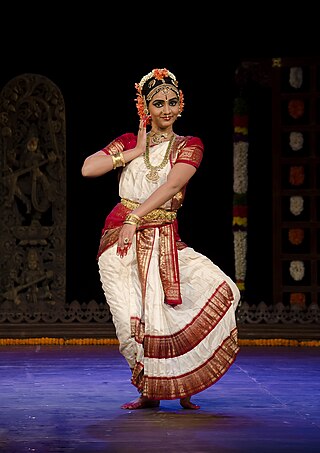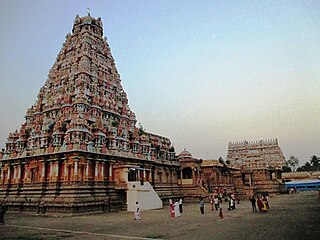
Bharatanatyam is an Indian classical dance form that originated in India. It is a classical dance form recognized by the Sangeet Natak Akademi, and expresses South Indian religious themes and spiritual ideas, of Hinduism and Jainism.

Kuchipudi is one of the eight major Indian classical dances. It originates from a village named Kuchipudi in the Indian state of Andhra Pradesh. Kuchipudi is a dance-drama performance, with its roots in the ancient Hindu Sanskrit text of Natya Shastra. It developed as a religious art linked to traveling bards, temples and spiritual beliefs, like all major classical dances of India.

The Kalaimamani is the highest civilian award in the state of Tamil Nadu, India. These awards are given by the Tamil Nadu Iyal Isai Nataka Mandram, a unit of the Directorate of Art and Culture, Government of Tamil Nadu, to recognise artists in the state for their achievements.
Adyar K. Lakshman was a noted Indian Bharatnatyam dancer, choreographer and guru.

Brihadishvara Temple, called Rajarajesvaram by its builder, and known locally as Thanjai Periya Kovil and Peruvudaiyar Kovil, is a Shaivite Hindu temple built in a Chola architectural style located on the south bank of the Cauvery river in Thanjavur, Tamil Nadu, India. It is one of the largest Hindu temples and an exemplar of Tamil architecture. It is also called Dakshina Meru. Built by Chola emperor Rajaraja I between 1003 and 1010 CE, the temple is a part of the UNESCO World Heritage Site known as the "Great Living Chola Temples", along with the Chola-era Gangaikonda Cholapuram temple and Airavatesvara temple, which are about 70 kilometres (43 mi) and 40 kilometres (25 mi) to its northeast respectively.
Saliyamangalam is a village in the Papanasam taluk of Thanjavur district, Tamil Nadu, India. It is one of the two places in Tamil Nadu where the Bhagavathar Melas are held, the other being Melattur.
Ammachatram is a village situated 6 km from Kumbakonam to Mayiladuthurai route on [State Highway ] and 277 km away from Chennai. The village is called Mela Ammachatram (West) and Ammachatram (East) that's centered in between UmaMaheswarapuram, Thirunageswaram(Famous for Rahu and Oppiliappan temple), Kumbakonam and Mayiladuthurai which is nearby the panchayat of Thepperumalnallur and comes under Kumbakonam and Thiruvidaimarudur Taluk in Thanjavur District. Ammachatram is a village in Kumbakonam taluk, Thanjavur district, Tamil Nadu.

The Melattur style of Bharatanatyam dance was developed largely out of the devadasi traditions and Melattur Bhagavata Mela by Mangudi Dorairaja Iyer (1900–1980), a sanyasi following Srividya Upasana.

The Kampaheswarar Temple or kampa-hara-ishvarar is a Hindu temple dedicated to the god Shiva. It is situated in Thirubuvanam, a village in Thanjavur district in the South Indian State of Tamil Nadu, on the Mayiladuthurai-Kumbakonam road. Shiva is worshiped as "Kampahareswarar" as he removed the quaking of a king who was being haunted by a Brahmarakshasa. It was built by Kulothunga Chola III and is considered the last of the four masterpieces built during the Medieval Chola era.

Garbharakshambigai Temple is a Hindu temple dedicated to Shiva located in Thirukarukavoor, Tamil Nadu, India. The temple is located 6 km (3.7 mi) east of Papanasam, 20 km (12 mi) south east of Kumbakonam, 10 km (6.2 mi) north of Saliyamangalam, 20 km (12 mi) north east of Thanjavur and on the southern bank of Vettar River. Nearest railway station is Papanasam Railway Station, which is 5 kms away from Thirukarukavoor. Constructed in the Dravidian style of architecture, the temple is believed to have been built during the Cholas period in the 7th century. Shiva is worshipped as Mullaivananathar and his consort Parvathi as Garbharakshambigai.

The Thiruvali - Thirunagari Temples are paired Hindu temples dedicated to Vishnu located 10 kilometres (6.2 mi) from Sirkali in Tamil Nadu, India, and 5 kilometres (3.1 mi) from each other. It is one of the Divya Desams, the 108 temples of Vishnu revered by the 12 poet saints, or Alvars. Unlike other Divya Desams where a single shrine is referred, this pair of temples is referred to together in all of the 41 pasurams (hymns). These temples follow the Tenkalai mode of worship.
V. D. Swami was an Indian industrialist and philanthropist who was one of the founders of the eye hospital Sankara Nethralaya in Chennai. He is the father of Tamil actor Arvind Swamy.

Harinie Jeevitha is an Indian classical dancer and choreographer. The disciple of Smt Sheela Unnikrishnan of Sridevi Nrithyalaya, she started dancing at the young age of six in the Melattur style of Bharathanatyam (Bharatanatyam).
Melattur Venkatarama Sastry (1770–1830) was a Telugu poet and playwright who is credited with founding the Bhagavatha Melas.
Bala Devi Chandrashekar is a Bharatanatyam dancer and teacher based in Princeton, New Jersey, United States. She was trained under Dr. Padma Subrahmanyam. Bala Devi Chandrashekar is a Professor of practice in Asian performing arts. Her approach is interdisciplinary, involving lecturing and research. Bala Devi's unique well researched productions include Nandanar Charithram, Krishnaarpnam and Uddhava Gita.
Pushpa Bhuyan was an Indian classical dancer specialising in the Indian classical dance forms of Bharatanatyam and Sattriya. She comes from the Northeast Indian state of Assam, and learned sattriya from Bhabananda Barbayan. She later studied bharatanatyam under Guru Mangudi Dorairaja Iyer. She has also tutored other dancers. A recipient of the North East Television Lifetime Achievement Award, Pushpa Bhuyan was honoured by the Government of India, in 2002, with the fourth highest Indian civilian award of Padma Shri.
Sridevi Nrithyalaya is a dance school based in Chennai, Tamil Nadu. The school was founded in 1987 and operates as a trust. The main aim of the institution is to support and promote the southern Indian classical dance form Bharathanatayam. It specialises in Melattur style of Bharathanayam.
Meenakshi Chitharanjan, an Indian classical dancer, teacher and choreographer, is known as an exponent of the Pandanallur style of the classical dance form of Bharatanatyam. She is the founder of Kaladiksha, an institution promoting Bharatanatyam and striving to preserve the Pandanallur tradition. A disciple of the father-son duo of Chokkalingam Pillai and Subbaraya Pillai, she is a recipient of several honours including Kalaimamani Award of the Government of Tamil Nadu and the Natya Kala Sarathi of Sri Parthasarathy Swami Sabha. The Government of India awarded her the fourth highest civilian honour of the Padma Shri, in 2008, for her contributions to classical dance.
Bhagavata Mela is a classical Indian dance that is performed in Tamil Nadu, particularly the Thanjavur area. It is choreographed as an annual Vaishnavism tradition in Melattur and nearby regions, and celebrated as a dance-drama performance art. The dance art has roots in a historic migration of practitioners of Kuchipudi, another Indian classical dance art, from Andhra Pradesh to the kingdom of Tanjavur.










